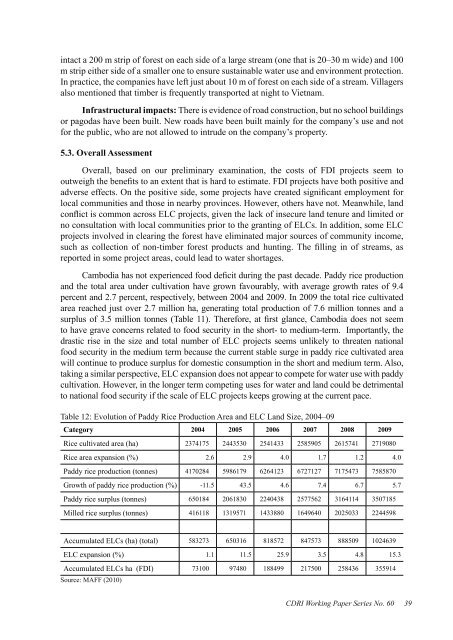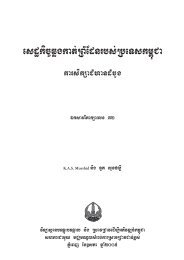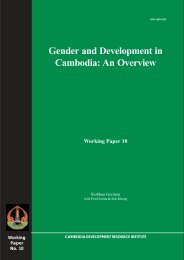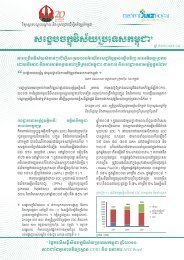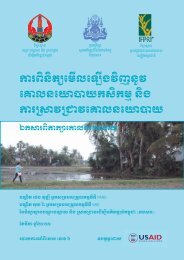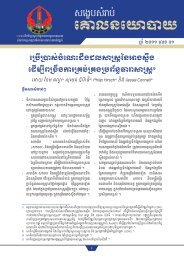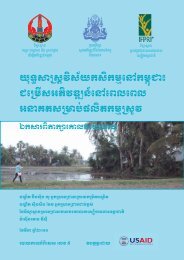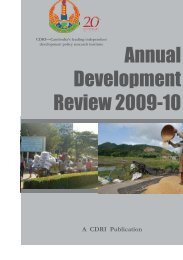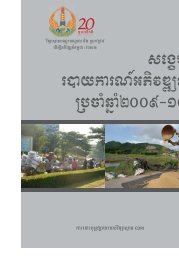Foreign Investment in Agriculture in Cambodia CDRI Working Paper ...
Foreign Investment in Agriculture in Cambodia CDRI Working Paper ...
Foreign Investment in Agriculture in Cambodia CDRI Working Paper ...
You also want an ePaper? Increase the reach of your titles
YUMPU automatically turns print PDFs into web optimized ePapers that Google loves.
<strong>in</strong>tact a 200 m strip of forest on each side of a large stream (one that is 20–30 m wide) and 100<br />
m strip either side of a smaller one to ensure susta<strong>in</strong>able water use and environment protection.<br />
In practice, the companies have left just about 10 m of forest on each side of a stream. Villagers<br />
also mentioned that timber is frequently transported at night to Vietnam.<br />
Infrastructural impacts: There is evidence of road construction, but no school build<strong>in</strong>gs<br />
or pagodas have been built. New roads have been built ma<strong>in</strong>ly for the company’s use and not<br />
for the public, who are not allowed to <strong>in</strong>trude on the company’s property.<br />
5.3. Overall Assessment<br />
Overall, based on our prelim<strong>in</strong>ary exam<strong>in</strong>ation, the costs of FDI projects seem to<br />
outweigh the benefits to an extent that is hard to estimate. FDI projects have both positive and<br />
adverse effects. On the positive side, some projects have created significant employment for<br />
local communities and those <strong>in</strong> nearby prov<strong>in</strong>ces. However, others have not. Meanwhile, land<br />
conflict is common across ELC projects, given the lack of <strong>in</strong>secure land tenure and limited or<br />
no consultation with local communities prior to the grant<strong>in</strong>g of ELCs. In addition, some ELC<br />
projects <strong>in</strong>volved <strong>in</strong> clear<strong>in</strong>g the forest have elim<strong>in</strong>ated major sources of community <strong>in</strong>come,<br />
such as collection of non-timber forest products and hunt<strong>in</strong>g. The fill<strong>in</strong>g <strong>in</strong> of streams, as<br />
reported <strong>in</strong> some project areas, could lead to water shortages.<br />
<strong>Cambodia</strong> has not experienced food deficit dur<strong>in</strong>g the past decade. Paddy rice production<br />
and the total area under cultivation have grown favourably, with average growth rates of 9.4<br />
percent and 2.7 percent, respectively, between 2004 and 2009. In 2009 the total rice cultivated<br />
area reached just over 2.7 million ha, generat<strong>in</strong>g total production of 7.6 million tonnes and a<br />
surplus of 3.5 million tonnes (Table 11). Therefore, at first glance, <strong>Cambodia</strong> does not seem<br />
to have grave concerns related to food security <strong>in</strong> the short- to medium-term. Importantly, the<br />
drastic rise <strong>in</strong> the size and total number of ELC projects seems unlikely to threaten national<br />
food security <strong>in</strong> the medium term because the current stable surge <strong>in</strong> paddy rice cultivated area<br />
will cont<strong>in</strong>ue to produce surplus for domestic consumption <strong>in</strong> the short and medium term. Also,<br />
tak<strong>in</strong>g a similar perspective, ELC expansion does not appear to compete for water use with paddy<br />
cultivation. However, <strong>in</strong> the longer term compet<strong>in</strong>g uses for water and land could be detrimental<br />
to national food security if the scale of ELC projects keeps grow<strong>in</strong>g at the current pace.<br />
Table 12: Evolution of Paddy Rice Production Area and ELC Land Size, 2004–09<br />
Category 2004 2005 2006 2007 2008 2009<br />
Rice cultivated area (ha) 2374175 2443530 2541433 2585905 2615741 2719080<br />
Rice area expansion (%) 2.6 2.9 4.0 1.7 1.2 4.0<br />
Paddy rice production (tonnes) 4170284 5986179 6264123 6727127 7175473 7585870<br />
Growth of paddy rice production (%) -11.5 43.5 4.6 7.4 6.7 5.7<br />
Paddy rice surplus (tonnes) 650184 2061830 2240438 2577562 3164114 3507185<br />
Milled rice surplus (tonnes) 416118 1319571 1433880 1649640 2025033 2244598<br />
Accumulated ELCs (ha) (total) 583273 650316 818572 847573 888509 1024639<br />
ELC expansion (%) 1.1 11.5 25.9 3.5 4.8 15.3<br />
Accumulated ELCs ha (FDI)<br />
Source: MAFF (2010)<br />
73100 97480 188499 217500 258436 355914<br />
<strong>CDRI</strong> Work<strong>in</strong>g <strong>Paper</strong> Series No. 60<br />
39


